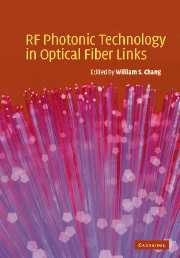Book contents
- Frontmatter
- Contents
- List of contributors
- Introduction and preface
- 1 Figures of merit and performance analysis of photonic microwave links
- 2 RF subcarrier links in local access networks
- 3 Analog modulation of semiconductor lasers
- 4 LiNbO3 external modulators and their use in high performance analog links
- 5 Broadband traveling wave modulators in LiNb03
- 6 Multiple quantum well electroabsorption modulators for RF photonic links
- 7 Polymer modulators for RF photonics
- 8 Photodiodes for high performance analog links
- 9 Opto-electronic oscillators
- 10 Photonic link techniques for microwave frequency conversion
- 11 Antenna-coupled millimeter-wave electro-optical modulators
- 12 System design and performance of wideband photonic phased array antennas
- Index
- References
5 - Broadband traveling wave modulators in LiNb03
Published online by Cambridge University Press: 06 July 2010
- Frontmatter
- Contents
- List of contributors
- Introduction and preface
- 1 Figures of merit and performance analysis of photonic microwave links
- 2 RF subcarrier links in local access networks
- 3 Analog modulation of semiconductor lasers
- 4 LiNbO3 external modulators and their use in high performance analog links
- 5 Broadband traveling wave modulators in LiNb03
- 6 Multiple quantum well electroabsorption modulators for RF photonic links
- 7 Polymer modulators for RF photonics
- 8 Photodiodes for high performance analog links
- 9 Opto-electronic oscillators
- 10 Photonic link techniques for microwave frequency conversion
- 11 Antenna-coupled millimeter-wave electro-optical modulators
- 12 System design and performance of wideband photonic phased array antennas
- Index
- References
Summary
Introduction
Traveling wave electro-optic devices were first proposed in 1963 and demonstrated, in LiNbO3 waveguide modulators in the late seventies. The basic requirements for broadband operation were known at the outset: velocity matching between the microwave and optical signals, low electrical loss in the microwave guide, and impedance matching between the microwave waveguide and external electrical connectors. However, these conditions were not immediately realized because the dielectric constants and refractive index of LiNbO3 made velocity mismatch inevitable, within the constraints of existing electrode geometries. Eventually, accurate modeling of the multilayer structure using numerical methods, combined with processing improvements, led to devices which were nearly velocity matched. Electrode thickness increased as the structures evolved, which naturally decreased the microwave loss, further extending device bandwidth.
Impedance matching has been considered a lower priority than velocity matching and low losses and was not achieved in a velocity matched device until etched ridge LiNbO3 devices were introduced. These devices concurrently satisfy the conditions for broadband operation, and operation beyond 100 GHz has recently been attained.
The development of broadband, low Vπ modulators is a final consideration. While the drive voltage can be decreased by lengthening the electrodes, this also increases electrode loss, resulting in a trade-off between drive voltage and bandwidth. Clearly, requirements for a particular application must be considered in modulator design.
This chapter covers the impressive progress that has been made in broadband LiNbO3 modulators over several decades, and addresses current challenges which face researchers.
- Type
- Chapter
- Information
- RF Photonic Technology in Optical Fiber Links , pp. 133 - 164Publisher: Cambridge University PressPrint publication year: 2002
References
- 3
- Cited by



